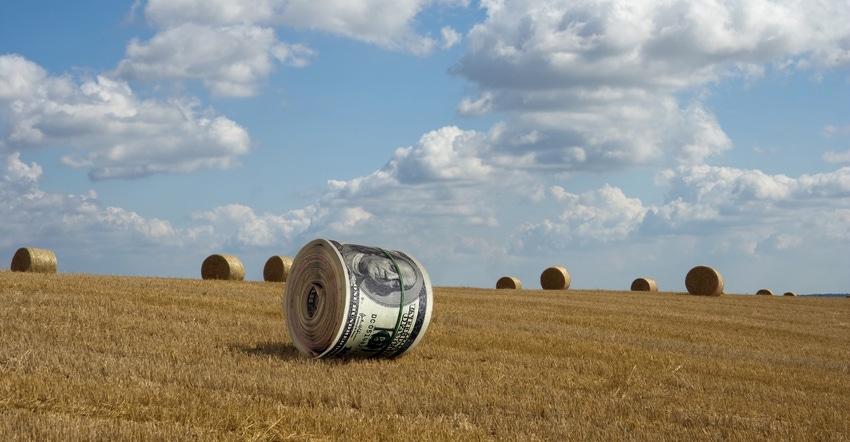Despite ballooning government payments for farmers, profits for agriculture sector strained.

The outbreak of COVID-19, as well as the U.S. government's response to the outbreak, continues to affect agricultural markets, disrupting supply chains, shifting consumer demand and expanding government outlays. Beyond the near-term opening of the economy, the macroeconomic contraction is likely to have longer-lasting effects, according to the latest baseline update offered by the University of Missouri’s Food & Agricultural Policy Research Institute (FAPRI).
FAPRI projects net farm income in 2020 to decline by 11% -- or about $3 billion -- in spite of record government payments of $33 billion. Back in February, the U.S. Department of Agriculture projected a $3.1 billion increase in net farm income for this year. Another farm income measure, net cash income, is projected to decline by $18 billion in 2020, with much of the difference in the two measures explained by changes in inventory values.
Net farm income for 2020 is able to be maintained at $90.6 billion with the help of government payments, but income will drop dramatically in 2021 to $79.4 billion. Meanwhile, farm receipts are forecasted at $383 billion in 2020, down from $408 billion in 2019.
Farm bill commodity program payments are projected to nearly double from 2020 to 2021 from an estimated $3.566 billion in payments in 2020 to $6.5 billion in 2021 and continue to climb in 2022 to $10.854 billion before slowly declining again to an estimated $7.729 billion by 2025.
In 2020, an influx of total government overlay for farmers, including the Coronavirus Food Assistance Program (CFAP) payments at $9.5 billion, will take total government payments to a record $50.5 billion, including crop insurance and $9.3 billion for Market Facilitation Program payments for the year.
FAPRI director Pat Westhoff said the $50 billion in government payments is an incredible amount of aid and significantly exceeds the previous record of $35 billion. The dramatic drop in 2021 is due partly to the unknowns if any of the current farm supports, such as the CFAP or trade mitigation payments, will be extended. Westhoff does not expect a dramatic recovery, so unless there are some additional payments, farm country will see a significant drop-off in farm income.
The debt-to-asset ratio is expected to climb from the 13.5% seen in 2019-21 to slightly higher at 14.2% in 2022 and climbing incrementally to 14.6% by 2025.
Westhoff said even though the debt-to-asset ratio is flat, debt will continue to increase. The general expectation when USDA puts out their land value report in August is that it will probably show a modest increase in land prices. As farmers feel pressured with operating loans, some land transactions are occurring, and that pushes up the value of those farm assets. FAPRI projects that asset values will start to pull back in 2022 as land values become less certain. Drawbacks in interest rates have helped support land values, he said.
This update was prepared the first week of June 2020. Macroeconomic assumptions were based on May forecasts by IHS Markit, which include a sharp economic contraction in 2020 and a recovery that keeps U.S. gross domestic product below previous estimates for several years. FAPRI said it allows for some market changes that facilitate trade consistent with implementation of the Phase One trade deal with China but reflect current conditions in which targets remain unmet for both 2020 and 2021.
As a result of supply chain disruptions, margins between live animal prices and wholesale meat prices have widened. Those supply chain impacts are assumed to be largely overcome in the months ahead. Projected levels for 2020 meat production are below previous estimates but exceed those in USDA’s May "World Agricultural Supply & Demand Estimates" report, FAPRI stated.
Corn planted area in 2020 is projected to be 96.0 million acres, second only to 2012 in the modern era but 1 million acres below the March "Planting Intentions" report. Record production of 15.5 billion bu. for the 2020-21 marketing year will cause carryout stocks to build and corn prices received by farmers to fall to $3.06/bu. While acreage should moderate in subsequent years, prices will rise only modestly.
Widespread shelter-at-home orders as a result of COVID-19 sharply reduced motor gasoline demand. Within a year, biofuel policy allows ethanol mandates to fall with unanticipated demand declines, cutting domestic biofuel use. Falling oil prices also provide headwinds to ethanol exports. “As a result, corn used for ethanol production for 2019-20 is the lowest since the drought year of 2012-13, when corn supplies were the limiting factor. Corn used for ethanol largely rebounds in 2020-21 as fuel demand returns and mandates are reset for calendar year 2021,” the report noted.
Projected soybean planted area will rebound to 84.5 million acres in 2020-21, up 8 million acres from 2019 and 1 million acres from the USDA planting report. Soybean stocks will decline in 2020-21 but remain above 500 million bu., with prices falling to $8.21/bu. “A rebalancing of corn and soybean area results in a further increase in soybean production in 2021, and soybean prices bottom out at $8.00/bu.,” FAPRI added.
Wheat prices should average about $4.60/bu. over the next five years, given large global supplies and demand‐side competition with corn. Lower global textile demand has contributed to lower cotton prices in the 2019-20 marketing year, and projected production will exceed use again in 2020-21, resulting in an even lower price.
About the Author(s)
You May Also Like





